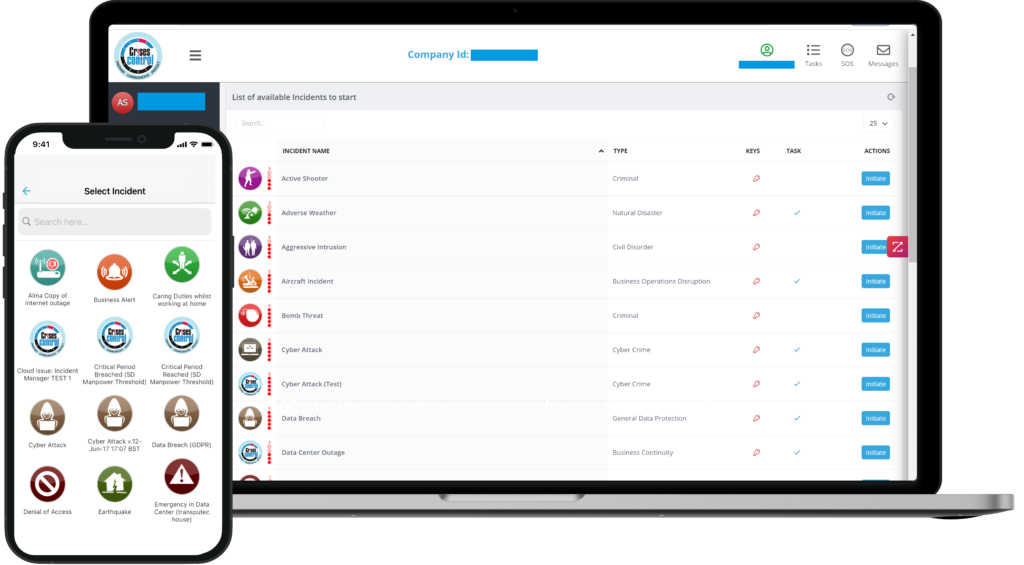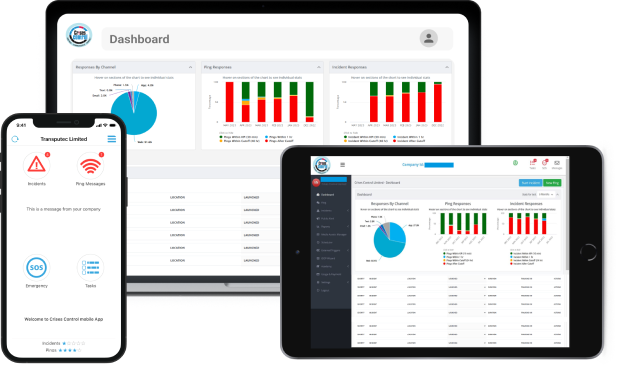Written by Ikram Tassi | Marketing
In the blink of an eye, your business could face an IT crisis—whether it’s a server failure, a security breach, or a system slowdown. The impact of such incidents can be catastrophic, leading to lost revenue, damaged reputations, and an interruption in service that customers simply can’t afford.
When these IT challenges arise, how quickly your team can respond can make the difference between a minor inconvenience and a full-blown disaster. This is where IT alerting software comes in.
Real-time alerts ensure that the right people are notified the instant something goes wrong, allowing your business to react quickly and minimise downtime. In today’s always-on digital world, downtime isn’t just an inconvenience; it’s a risk to your business’s survival.
In this blog, we’ll explore how IT alerting software for business continuity keeps your organisation running during IT emergencies, and how Crises Control, a leading business continuity platform, can help ensure your company is always prepared for whatever IT challenges come your way.
What is IT Alerting Software?
IT alerting software is a tool that monitors your IT systems and immediately notifies your team when something goes wrong. Whether it’s a server going down, a performance dip, or a security threat, these systems deliver instant notifications to the appropriate people—usually via email, SMS, or mobile push notifications.
The goal is simple: catch problems early so you can prevent them from escalating into larger, more disruptive crises. Think of it as your IT team’s early warning system—alerting them to issues long before they start affecting your business operations.
Here’s how it works:
- Real-time Monitoring: IT alerting software continuously scans your network, servers, and systems for abnormalities, such as unusual traffic spikes or hardware malfunctions.
- Instant Alerts: As soon as a potential issue is detected, it sends an automated alert to the right people. This helps catch problems early before they can disrupt the business.
- Actionable Information: The alert typically includes detailed information about the issue, including its severity and location, so teams can take immediate action.
By setting up IT alerting software, businesses gain visibility into their IT environment, allowing them to make faster, more informed decisions during emergencies.
The Importance of IT Alerting Software for Business Continuity
In the world of business, time is money. Every minute spent dealing with IT issues can lead to lost revenue, unhappy customers, and even a damaged reputation. That’s why IT alerting software is an essential tool for maintaining business continuity.
Let’s dive into how these systems help businesses stay on track during IT emergencies.
1. Minimising Downtime and Financial Losses
When an IT issue occurs, the clock starts ticking. Whether it’s a glitch in your payment system or a network outage, downtime means you’re losing productivity, and often, revenue. According to research, the average cost of downtime for a business is around £4,500 per minute, which can quickly escalate if the issue goes unnoticed.
With IT alerting software, your team gets an instant notification, enabling them to start working on the solution immediately. The faster you can resolve the issue, the less impact it will have on your bottom line. Crises Control, for example, integrates seamlessly with your IT systems to provide instant alerts for all types of IT failures, minimising downtime and reducing the financial burden on your business.
2. Improving Decision-Making and Speed of Response
When a crisis strikes, having real-time, actionable data is crucial. IT alerting software allows your team to understand the severity of the problem right away, so they can respond appropriately.
3. Streamlining Communication Across Teams
Effective communication is key during any crisis. IT alerting software helps streamline communication by notifying relevant teams simultaneously. When an issue arises, your IT, security, operations, and customer service teams can be alerted at the same time, which ensures everyone is on the same page and ready to act.
This synchronisation reduces response time and minimises the chances of overlooked or delayed actions.
How Crises Control Enhances IT Alerting for Business Continuity
While basic IT alerting systems provide notifications, Crises Control takes it a step further by integrating real-time alerts into a comprehensive business continuity platform. With its wide range of features, Crises Control ensures that businesses can not only detect IT issues early, but also manage the entire crisis-response process efficiently.
1. Seamless Integration with Your IT Systems
Crises Control works alongside your existing IT infrastructure, such as monitoring tools, cloud services, and network systems. It integrates effortlessly with your current setup, ensuring you don’t have to overhaul your entire IT ecosystem to begin using its alerting features.
This integration means you can monitor all critical systems in real-time and receive detailed alerts for issues that require immediate attention. Whether you use cloud-based applications, on-premise hardware, or a hybrid model, Crises Control provides centralised monitoring and alerting.
2. Multi-Channel Alerting for Maximum Coverage
Unlike some basic alerting tools, Crises Control sends alerts across multiple channels, including SMS, email, mobile push notifications, and phone calls. This ensures that no matter where your team members are or what devices they use, they’ll receive the alert instantly.
This flexibility is particularly valuable for organisations with remote teams or employees working across different time zones. Immediate alerts through multiple channels increase the chances of a quick response, no matter where or when an issue arises.
3. Automated Escalation and Incident Management
Crises Control offers automated escalation features, which means critical issues are automatically flagged and sent to the appropriate team members based on their expertise and role. If an alert is not acted upon within a specific time frame, the system escalates it to the next level of management. This ensures that urgent issues don’t fall through the cracks, and you can address them promptly.
Furthermore, Crises Control provides incident management tools, which help your team organise and track the progress of resolution efforts. With a centralised dashboard, you can see all active incidents in real-time, monitor their status, and ensure that nothing is overlooked.
4. Communication and Collaboration in Crisis Mode
When an incident happens, it’s essential for your teams to stay connected and coordinate their efforts. Crises Control features built-in communication tools that allow your IT, security, and business teams to chat in real time, assign tasks, and share updates. This streamlines the process of incident resolution and ensures that everyone is aligned throughout the crisis.

Interested in our Incident Management Software?
Customise your Crisis Incident Management Software to meet your specific needs with our flexible tools & stay connected and informed during the crisis and incident management process
The Real Benefits of IT Alerting Software for Your Organisation
Adopting IT alerting software for business continuity brings several key benefits:
1. Enhanced Business Resilience
By detecting issues early and responding quickly, your business can maintain continuity during IT incidents, preventing long-lasting disruptions.
2. Cost Savings
Fast detection and resolution of IT problems lead to fewer disruptions and reduced costs. By minimising downtime, businesses can avoid the expensive consequences of prolonged outages.
3. Increased Efficiency
Automated alerts and escalation workflows ensure that your team is always focused on the most critical tasks, improving overall operational efficiency.
4. Better Preparedness for Crises
Proactively monitoring and addressing IT issues makes your business more resilient to crises, helping you recover quickly when an emergency arises.
How to Implement IT Alerting Software in Your Organisation
Now that you understand the importance of IT alerting software, here are the key steps for implementing it effectively:
1. Assess Your Needs
Identify the key IT systems that need monitoring and alerting. This could include your network infrastructure, cloud services, critical applications, or security systems.
2. Integrate Crises Control
Integrate Crises Control with your existing IT tools. The software is designed to work alongside your current systems, ensuring you get the benefits of real-time alerting without disrupting your existing workflow.
3. Configure Alerts and Escalation Procedures
Set up custom alerts based on the severity of issues and the roles of your team members. Make sure to configure automated escalation protocols so that critical issues are promptly addressed.
4. Train Your Team
Ensure that all relevant team members know how to respond to alerts and use the Crises Control platform efficiently. Training is key to ensuring your team can react quickly in the event of an IT crisis.
5. Test the System Regularly
Test your IT alerting system regularly to ensure it works as expected. Running simulations can help identify any gaps in your crisis management processes and give your team the confidence they need when a real incident occurs.
Conclusion: Be Prepared for the Unexpected – Contact Us for a Free Demo
In today’s digital landscape, IT alerting software is a must-have for businesses that want to stay ahead of IT disruptions. With real-time alerts and a comprehensive business continuity platform like Crises Control, you can ensure that your organisation is ready to respond swiftly and effectively during any IT crisis.
Don’t wait for the next IT issue to catch you off guard—be proactive in managing risks and maintaining business continuity.
Ready to see how Crises Control can transform your crisis management strategy? Contact us today to get a free demo and discover how our IT alerting software can help your business stay resilient in the face of emergencies.
Request a FREE Demo

